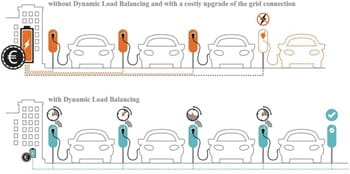
| Have tickets for sports events in Paris this summer? You’ve planned your trip, but have you thought about where to park?
Read more
Creating e-charging infrastructure is not as simple as it sounds. It requires much more than a simple electric socket in the wall. Public and private parties need to be aware of grid capacity, capital expenditures and upcoming directives.
Electric vehicles are here to stay and unlike the trusty steel steeds of yesteryear that can be topped up with liquid fuel in less than five minutes, EVs take a bit longer. Thus their owners want to replenish the charge while they are doing something else.
This is fuelling demand for e-charging stations that can be used when cars are parked; parked in public parking facilities, in office car parks and at homes.
Since the first EVs hit the road, Q-Park has been innovating to meet this demand as efficiently and effectively as possible. But it is important to know that creating e-charging infrastructure is not as simple as it sounds. It requires much more than a simple electric socket in the wall.
Public and private parties need to be aware of:
Electricity supply to buildings throughout Europe is typically three phase high-voltage current. This delivers 230 V x 16 A x 3 = 11,040 Watt (11 kW). This is generally sufficient to power most appliances in a general-purpose building (such as a car park), office complex or home.
Businesses requiring more than the standard power can apply for additional capacity, i.e. a second or third power line. In densely populated urban areas such requests cannot always be met as the electricity infrastructure simply does not have the capacity. Now that power for EV charging is required almost everywhere, grid capacity is becoming a serious challenge.
For example: an average 'out-of-home' EV charging station draws 7.6 kW, which means that parking facilities need to apply for additional 11kW capacity just to serve 2 charging points. But what about serving a fleet of 20 or 50 EV cars?

There are many questions that still need to be answered:
Each parking facility is unique and requires an individual solution. We draw on our experience and expertise and use the EV-charging building blocks we have developed in recent years to achieve the most feasible and commercially viable solution per parking facility.
We invite landlords and partners facing EV charging dilemmas to get in touch. Together we can create quality parking solutions that make a major contribution to reducing CO2 emissions and add value to social and environmental well-being.

Dynamic load balancing serves more cars concurrently





